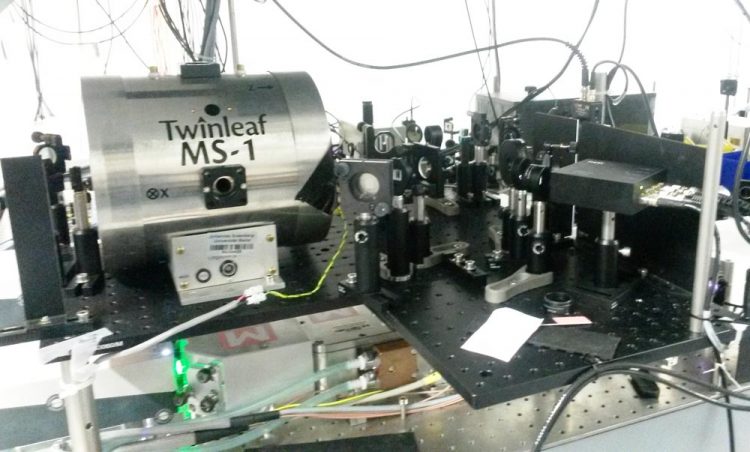Cesium vapor aids in the search for dark matter

Experimental setup for atomic spectroscopy using cesium atom vapor photo: Dionysis Antypas
The hunt for dark matter is one of the most exciting challenges facing fundamental physics in the 21st century. Researchers have long known that it must exist, as many astrophysical observations would otherwise be impossible to explain. For example, stars rotate much faster in galaxies than they would if only 'normal' matter existed.
In total, the matter we can see only accounts for, at the most, 20 percent of the total matter in the universe – meaning that a remarkable 80 percent is dark matter. “There's an elephant in the room but we just can't see it,” said Professor Dmitry Budker, a researcher at the PRISMA+ Cluster of Excellence of Johannes Gutenberg University Mainz (JGU) and the Helmholtz Institute Mainz (HIM), explaining the problem he and many of his colleagues worldwide are contending with.
Dark matter could consist of extremely light particles
But so far no one knows what dark matter is made of. Scientists in the field are considering and researching a whole range of possible particles that might theoretically qualify as candidates. Among these are extremely lightweight bosonic particles, currently considered to be one of the most promising prospects.
“These can also be regarded as a classical field oscillating at a specific frequency. But we can't yet put a figure on this – and therefore the mass of the particles,” explained Budker. “Our basic assumption is that this dark matter field is coupled to visible matter and has an extremely subtle influence on certain atomic properties that would normally be constant.”
Budker and his team in Mainz have now developed a new method which they describe in the current issue of the leading specialist journal Physical Reviews Letters. It employs atomic spectroscopy and involves the use of cesium atom vapor.
Only on exposure to laser light of a very specific wavelength do these atoms become excited. The conjecture is that minute changes in the corresponding observed wavelength would indicate coupling of the cesium vapor to a dark matter particle field.
“In principle, our work is based on a particular theoretical model, the hypotheses of which we are experimentally testing,” added the paper's principal author, Dr. Dionysis Antypas. “In this case, the concept underlying our work is the relaxion model developed by our colleagues and co-authors at the Weizmann Institute in Israel.” According to the relaxion theory, there must be a region in the vicinity of large masses such as the Earth in which the density of dark matter is greater, making the coupling effects easier to observe and detect.
Previously inaccessible frequency range searched
With their new technique, the scientists have now accessed a hitherto unexplored frequency range in which, as postulated in relaxion theory, the effects of certain forms of dark matter on the atomic properties of cesium should be relatively easy to spot. The results also allow the researchers to formulate new restrictions as to what the nature of dark matter is likely to be. Dmitry Budker likens this meticulous search to the hunt for a tiger in a desert.
“In the frequency range that we've explored in our current work, we still have not pinpointed dark matter. But at least, now that we've searched in this range, we know we don't have to do it again.” The researchers still don't know where dark matter – the tiger in his metaphor – is lurking, but they now know where it is not. “We just keep on targeting in more closely on the part of the desert where the tiger is most likely to be. And, at some point, we will catch him,” maintained Budker with confidence.
Prof. Dr. Dmitry Budker
Quantum, Atomic and Neutron Physics (QUANTUM)
Institute of Physics and PRISMA+ Cluster of Excellence
Johannes Gutenberg University Mainz
55099 Mainz, GERMANY
phone +49 6131 39-29630
e-mail: budker@uni-mainz.de
https://bukder.uni-mainz.de/
D. Antypas, O. Tretiak, A. Garcon, R. Ozeri, G. Perez, and D. Budker
Scalar Dark Matter in the Radio-Frequency Band: Atomic-Spectroscopy Search Results
Phys. Rev. Lett. 123, 141102 (2019)
DOI: https://journals.aps.org/prl/abstract/10.1103/PhysRevLett.123.141102
Media Contact
All latest news from the category: Physics and Astronomy
This area deals with the fundamental laws and building blocks of nature and how they interact, the properties and the behavior of matter, and research into space and time and their structures.
innovations-report provides in-depth reports and articles on subjects such as astrophysics, laser technologies, nuclear, quantum, particle and solid-state physics, nanotechnologies, planetary research and findings (Mars, Venus) and developments related to the Hubble Telescope.
Newest articles

A ‘language’ for ML models to predict nanopore properties
A large number of 2D materials like graphene can have nanopores – small holes formed by missing atoms through which foreign substances can pass. The properties of these nanopores dictate many…

Clinically validated, wearable ultrasound patch
… for continuous blood pressure monitoring. A team of researchers at the University of California San Diego has developed a new and improved wearable ultrasound patch for continuous and noninvasive…

A new puzzle piece for string theory research
Dr. Ksenia Fedosova from the Cluster of Excellence Mathematics Münster, along with an international research team, has proven a conjecture in string theory that physicists had proposed regarding certain equations….



